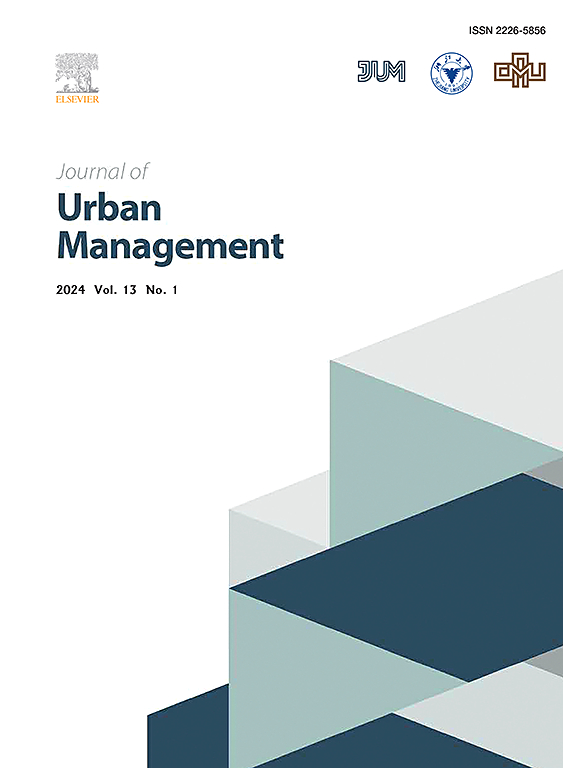GIS and remote sensing methods in predicting the dissipation time of rural settlements under the influence of climate change in the Republic of Serbia
IF 5
2区 社会学
Q1 URBAN STUDIES
引用次数: 0
Abstract
In this research the specific methodology used to better analyzed rural settlements and they properties. The Geographical Information Systems and Remote Sensing approaches taken to connect rural settlements with the climate change effects in Serbia. For the first time the classification of settlements after approved methodology divided in accordance of new spatial relations within the situation in Serbia. Ten morphometric types of rural settlements were analyzed in terms of social, economic, transport, demographic and climatic factors. The effects of climate change, estimated in this study, will become even more noticeable by 2050. The results showed that the rural settlements (villages) in southern and eastern Serbia are very similar to the villages in central Banat in terms of resolution and low value of mitigation of the effects of climate change. In 2050, 35% of the villages in the south, 30% in the east, and 23% in other regions will be dissipated. The total number of dissipated rural settlements in the period from 2011 to 2050 is 680 or 15% in total. By means of GIS and remote sensing methods, all rural settlements were mapped and presented statistically, along with their characteristics. This method is useful for the analysis of rural settlements with 0–15,000 inhabitants. The shape of the settlements was also analyzed and the zones with the strongest impacts of climate change were marked. The hazardous events are divided into extreme rainfall, wind, drought and maximum temperatures and compared with the types of rural settlements. The climate factors included, together with other parameters such as socio-economic, demographic and urban planning factors, provide a complete overview and a better understanding of the survival of rural settlements in the future. The main contribution of this research is the creation of a new classification of rural settlements, taking into account the effects of climate change and new socio-economic theories. In this way, the old classifications and theories that were established fifty years ago will be improved.
气候变化影响下塞尔维亚共和国农村聚落消散时间的GIS和遥感预测方法
在本研究中,使用了具体的方法来更好地分析农村聚落及其性质。为将塞尔维亚农村住区与气候变化影响联系起来而采取的地理信息系统和遥感方法。这是第一次根据塞尔维亚局势内新的空间关系按照核定方法对住区进行分类。从社会、经济、交通、人口和气候等方面分析了10种形态计量学类型的农村聚落。这项研究估计,到2050年,气候变化的影响将变得更加明显。结果表明,塞尔维亚南部和东部的农村住区(村)与巴纳特中部的村庄在缓解气候变化影响的分辨率和低价值方面非常相似。到2050年,南方35%的村庄、东部30%的村庄和其他地区23%的村庄将会消失。2011年至2050年,我国农村散失聚落总数为680个,占全国散失聚落总数的15%。利用地理信息系统和遥感方法,对所有农村居民点及其特征进行了制图和统计。这种方法对人口在0 - 1.5万人之间的农村居民点的分析很有用。对聚落的形状进行了分析,并标出了受气候变化影响最大的区域。将灾害事件分为极端降雨、极端大风、极端干旱和极端高温,并与农村住区类型进行了比较。所包括的气候因素,连同诸如社会经济、人口和城市规划因素等其他参数,提供了一个完整的概貌,并更好地了解农村住区未来的生存情况。这项研究的主要贡献是创建了一种新的农村住区分类,考虑到气候变化的影响和新的社会经济理论。这样,50年前建立的旧分类和理论将得到改进。
本文章由计算机程序翻译,如有差异,请以英文原文为准。
求助全文
约1分钟内获得全文
求助全文
来源期刊

Journal of Urban Management
URBAN STUDIES-
CiteScore
9.50
自引率
4.90%
发文量
45
审稿时长
65 days
期刊介绍:
Journal of Urban Management (JUM) is the Official Journal of Zhejiang University and the Chinese Association of Urban Management, an international, peer-reviewed open access journal covering planning, administering, regulating, and governing urban complexity.
JUM has its two-fold aims set to integrate the studies across fields in urban planning and management, as well as to provide a more holistic perspective on problem solving.
1) Explore innovative management skills for taming thorny problems that arise with global urbanization
2) Provide a platform to deal with urban affairs whose solutions must be looked at from an interdisciplinary perspective.
 求助内容:
求助内容: 应助结果提醒方式:
应助结果提醒方式:


